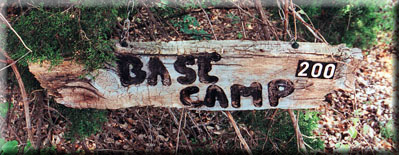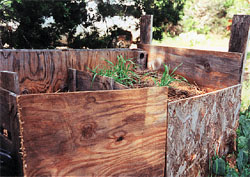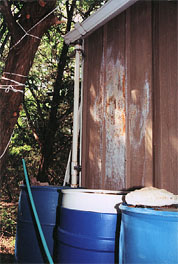
I currently live with my girlfriend, Denise, on my two-acre property in the Central Texas hill country in my 8' x 8' house, her 25-foot travel trailer, and an 8' x 12' office that used to be a
snow-cone stand.
By living simply, we free up a lot of the money that we would normally spend on housing.
We take time away from work and live out as many dreams as we can.
Indeed, our home is primitive at first glance, but I think of it more as a base camp for
journeys than as a permanent home. We collect rainwater, compost all human "waste", and spend
summers in the shade without air conditioning. The entire base camp, including the property,
trailer, two sheds, house, and "snow cone" office, has cost about as much as a Toyota Camry.
I pay $300 each year in taxes, and we have no monthly housing expenses except for telephone
and electricity bills. Getting to spend money on dreams rather than on housing does not
feel primitive to me! Besides, base camps have no identity without satellite camps in other
locales. If I felt too cozy at home, I might feel less motivated to venture out into the world.
I typically spend at least two months a year in Colorado at Camp One (see below).
 I built this 50-square-foot house a few years back. Above the level of the front door
is a loft with a full-sized futon mattress in it. The walls inside are lined
entirely with various shapes of shelves and a built-in desk. It gives new meaning
to "efficient use of space." Behind the bushes, a floorless 8' x 12' shed hangs
off the side of the house. We collect rain off of the microhouse roof and the
adjoining shed roof (see below).
I built this 50-square-foot house a few years back. Above the level of the front door
is a loft with a full-sized futon mattress in it. The walls inside are lined
entirely with various shapes of shelves and a built-in desk. It gives new meaning
to "efficient use of space." Behind the bushes, a floorless 8' x 12' shed hangs
off the side of the house. We collect rain off of the microhouse roof and the
adjoining shed roof (see below).
 My girlfriend's travel trailer. It stays cool under the big oak trees and there is
never a need to run the air conditioner. I get to use the kitchen and bathroom,
but mostly the trailer holds all of Denise's stuff. I keep my stuff in the "snow cone"
office and the microhouse.
My girlfriend's travel trailer. It stays cool under the big oak trees and there is
never a need to run the air conditioner. I get to use the kitchen and bathroom,
but mostly the trailer holds all of Denise's stuff. I keep my stuff in the "snow cone"
office and the microhouse.
 I compost all organic materials, including humanure
(see humanure). This avoids
creating human waste, thus completing nature's nutrient cycle. The finished compost goes onto
our rain-fed garden.
I compost all organic materials, including humanure
(see humanure). This avoids
creating human waste, thus completing nature's nutrient cycle. The finished compost goes onto
our rain-fed garden.
 I built this green shed before moving to the property. It holds bikes and some boxes and
provided my first rainwater collection system. The rain flows down the roof, into the
gutters, and then into the rain barrel. One barrel of water could last us for two or three weeks
in the summer, and longer in the winter. We kept the showers short!
I built this green shed before moving to the property. It holds bikes and some boxes and
provided my first rainwater collection system. The rain flows down the roof, into the
gutters, and then into the rain barrel. One barrel of water could last us for two or three weeks
in the summer, and longer in the winter. We kept the showers short!
 The second, more advanced rainwater collection system. This time, rain flows off of the 8' x 8' house and
the adjoining shed. I had four barrels here and an 8-gallon pressure tank with a small pump
that automatically pumps water from the barrels, thus providing standard household water pressure
(30 to 50 psi). I had to occasionally switch which barrel the hose drew from. With system, I no longer had
to make trips to a nearby friend to get a tank of well-water. I had also intended to connect the barrels
into a system, but ended up going straight to the third rainwater collection system.
More details will come for system #3, which includes a 1500-gallon tank and two filters.
The second, more advanced rainwater collection system. This time, rain flows off of the 8' x 8' house and
the adjoining shed. I had four barrels here and an 8-gallon pressure tank with a small pump
that automatically pumps water from the barrels, thus providing standard household water pressure
(30 to 50 psi). I had to occasionally switch which barrel the hose drew from. With system, I no longer had
to make trips to a nearby friend to get a tank of well-water. I had also intended to connect the barrels
into a system, but ended up going straight to the third rainwater collection system.
More details will come for system #3, which includes a 1500-gallon tank and two filters.
 When you don't use AC, having shady living space is nice. Here, we keep the mosquitoes out. We call it
the "mosaicking studio" because we originally used it for doing such crafts. It seems that making jewelry
has replaced Denise's interest in mosaicking, and she typically motivated me to do it, so this space remains
idle.
When you don't use AC, having shady living space is nice. Here, we keep the mosquitoes out. We call it
the "mosaicking studio" because we originally used it for doing such crafts. It seems that making jewelry
has replaced Denise's interest in mosaicking, and she typically motivated me to do it, so this space remains
idle.
 A friend, Jim Kennedy, basically gave this Happy Hippy Bus to me. I have fixed it up a bit,
but we tend to use it for storage since it gets so hot in the summer. Sometime, I may finish
hooking up the shower and electrical systems in it. Before I got it, someone had begun converting
it into an RV, but they never finished it. By the time I got it, it had a large cavity where the engine presumably once lived.
A friend, Jim Kennedy, basically gave this Happy Hippy Bus to me. I have fixed it up a bit,
but we tend to use it for storage since it gets so hot in the summer. Sometime, I may finish
hooking up the shower and electrical systems in it. Before I got it, someone had begun converting
it into an RV, but they never finished it. By the time I got it, it had a large cavity where the engine presumably once lived.
 Camp One is an off-the-grid cabin in Pagosa Springs, Colorado, that I built during two
summers. I think of it as my Rocky Mountain writing studio, and it has served its purpose well.
The 10' x 12' cabin sits on a pretty 1.2 acre lot surrounded by ponderosa pine trees. Denise and
I spend time in the cabin each year while backpacking in the surrounding Rocky Mountains. In fact,
I am sitting in this solar-powered cabin as I type this on my notebook computer.
Camp One is an off-the-grid cabin in Pagosa Springs, Colorado, that I built during two
summers. I think of it as my Rocky Mountain writing studio, and it has served its purpose well.
The 10' x 12' cabin sits on a pretty 1.2 acre lot surrounded by ponderosa pine trees. Denise and
I spend time in the cabin each year while backpacking in the surrounding Rocky Mountains. In fact,
I am sitting in this solar-powered cabin as I type this on my notebook computer.
Home
 I built this 50-square-foot house a few years back. Above the level of the front door
is a loft with a full-sized futon mattress in it. The walls inside are lined
entirely with various shapes of shelves and a built-in desk. It gives new meaning
to "efficient use of space." Behind the bushes, a floorless 8' x 12' shed hangs
off the side of the house. We collect rain off of the microhouse roof and the
adjoining shed roof (see below).
I built this 50-square-foot house a few years back. Above the level of the front door
is a loft with a full-sized futon mattress in it. The walls inside are lined
entirely with various shapes of shelves and a built-in desk. It gives new meaning
to "efficient use of space." Behind the bushes, a floorless 8' x 12' shed hangs
off the side of the house. We collect rain off of the microhouse roof and the
adjoining shed roof (see below).
 My girlfriend's travel trailer. It stays cool under the big oak trees and there is
never a need to run the air conditioner. I get to use the kitchen and bathroom,
but mostly the trailer holds all of Denise's stuff. I keep my stuff in the "snow cone"
office and the microhouse.
My girlfriend's travel trailer. It stays cool under the big oak trees and there is
never a need to run the air conditioner. I get to use the kitchen and bathroom,
but mostly the trailer holds all of Denise's stuff. I keep my stuff in the "snow cone"
office and the microhouse.
 I compost all organic materials, including humanure
(see humanure). This avoids
creating human waste, thus completing nature's nutrient cycle. The finished compost goes onto
our rain-fed garden.
I compost all organic materials, including humanure
(see humanure). This avoids
creating human waste, thus completing nature's nutrient cycle. The finished compost goes onto
our rain-fed garden.
 I built this green shed before moving to the property. It holds bikes and some boxes and
provided my first rainwater collection system. The rain flows down the roof, into the
gutters, and then into the rain barrel. One barrel of water could last us for two or three weeks
in the summer, and longer in the winter. We kept the showers short!
I built this green shed before moving to the property. It holds bikes and some boxes and
provided my first rainwater collection system. The rain flows down the roof, into the
gutters, and then into the rain barrel. One barrel of water could last us for two or three weeks
in the summer, and longer in the winter. We kept the showers short!
 When you don't use AC, having shady living space is nice. Here, we keep the mosquitoes out. We call it
the "mosaicking studio" because we originally used it for doing such crafts. It seems that making jewelry
has replaced Denise's interest in mosaicking, and she typically motivated me to do it, so this space remains
idle.
When you don't use AC, having shady living space is nice. Here, we keep the mosquitoes out. We call it
the "mosaicking studio" because we originally used it for doing such crafts. It seems that making jewelry
has replaced Denise's interest in mosaicking, and she typically motivated me to do it, so this space remains
idle.
 A friend, Jim Kennedy, basically gave this Happy Hippy Bus to me. I have fixed it up a bit,
but we tend to use it for storage since it gets so hot in the summer. Sometime, I may finish
hooking up the shower and electrical systems in it. Before I got it, someone had begun converting
it into an RV, but they never finished it. By the time I got it, it had a large cavity where the engine presumably once lived.
A friend, Jim Kennedy, basically gave this Happy Hippy Bus to me. I have fixed it up a bit,
but we tend to use it for storage since it gets so hot in the summer. Sometime, I may finish
hooking up the shower and electrical systems in it. Before I got it, someone had begun converting
it into an RV, but they never finished it. By the time I got it, it had a large cavity where the engine presumably once lived.
 Camp One is an off-the-grid cabin in Pagosa Springs, Colorado, that I built during two
summers. I think of it as my Rocky Mountain writing studio, and it has served its purpose well.
The 10' x 12' cabin sits on a pretty 1.2 acre lot surrounded by ponderosa pine trees. Denise and
I spend time in the cabin each year while backpacking in the surrounding Rocky Mountains. In fact,
I am sitting in this solar-powered cabin as I type this on my notebook computer.
Camp One is an off-the-grid cabin in Pagosa Springs, Colorado, that I built during two
summers. I think of it as my Rocky Mountain writing studio, and it has served its purpose well.
The 10' x 12' cabin sits on a pretty 1.2 acre lot surrounded by ponderosa pine trees. Denise and
I spend time in the cabin each year while backpacking in the surrounding Rocky Mountains. In fact,
I am sitting in this solar-powered cabin as I type this on my notebook computer.